1998 GMC SIERRA tow
[x] Cancel search: towPage 166 of 452
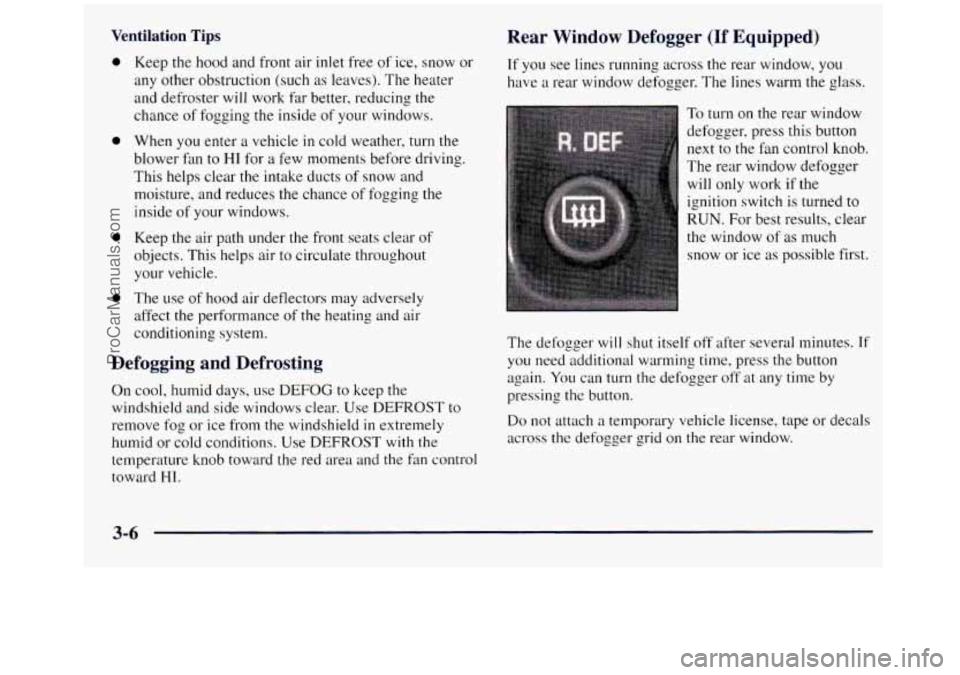
Ventilation Tips
0
0
0
0
Keep the hood and front air inlet free of ice, snow or
any other obstruction (such
as leaves). The heater
and defroster will work far better, reducing the
chance
of fogging the inside of your windows.
When you enter a vehicle
in cold weather, turn the
blower fan to
HI for a few moments before driving.
This helps clear the intake ducts of snow and
moisture, and reduces the chance of fogging the
inside of your windows.
Keep
the air path under the front seats clear of
objects. This helps air
to circulate throughout
your vehicle.
The use of hood air deflectors may adversely
affect
the performance of the heating and air
conditioning system.
Defogging and Defrosting
On cool, humid days, use DEFOG to keep the
windshield and side windows clear. Use
DEFROST to
remove fog
or ice from the windshield in extremely
humid or cold conditions. Use DEFROST with the
temperature knob toward the red area and the fan control
toward
HI.
Rear Window Defogger (If Equipped)
If you see lines running across the rear window, you
have
a rear window defogger. The lines warm the glass.
To turn on the rear window
defogger, press this button
next to the fan control knob.
The rear window defogger will only work if the
ignition switch is turned to
RUN. For best results, clear
the window of as much
snow or ice
as possible first.
The defogger
will shut itself off after several minutes. If
you need additional warming time, press the button
again.
You can turn the defogger off at any time by
pressing the button.
Do not attach a temporary vehicle license, tape or decals
across the defogger grid on the rear window.
ProCarManuals.com
Page 189 of 452
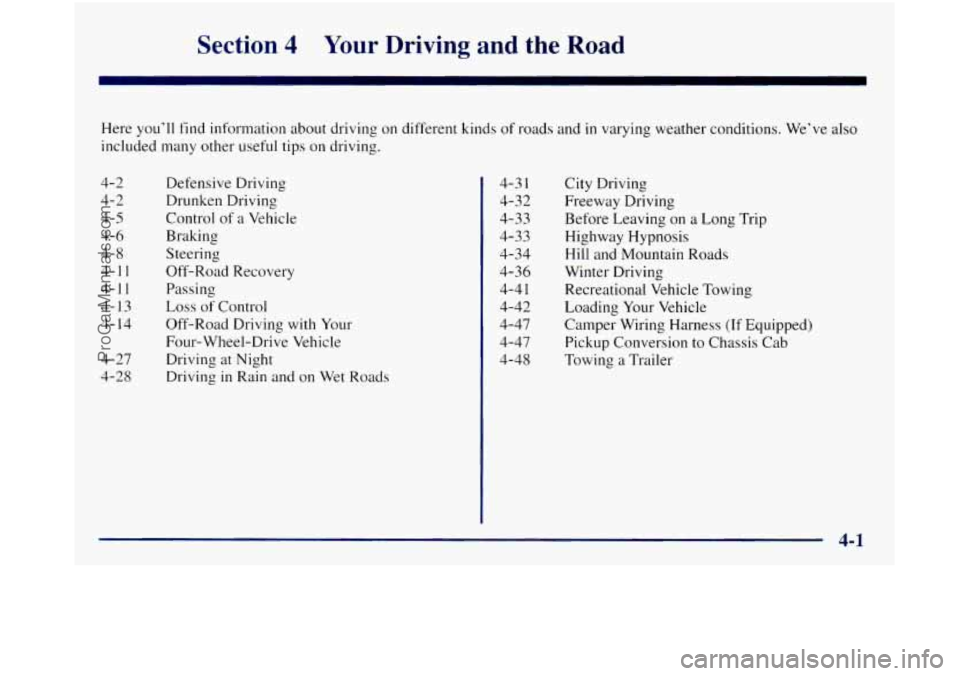
Section 4 Yoiir Driving and the Road
Here you’ll find information about driving on different kinds of roads and in varying weather conditions. We’ve also
included many other useful tips on driving.
4-
2
4- 2
4-5
4-6
4- 8
4-1
1
4-1 1
4- 13
4- 14
4-27
4-28
Defensive Driving Drunken Driving
Control of a Vehicle
Braking
Steering
Off-Road Recovery Passing
Loss of Control
Off-Road Driving with Your
Four-Wheel-Drive Vehicle
Driving at Night
Driving
in Rain and on Wet Roads 4-3
1
4-32
4-33
4-33
4-34
4-36 4-4
1
4-42
4-47
4-47
4-48 City Driving
Freeway Driving
Before Leaving
on a Long Trip
Highway Hypnosis
Hill and Mountain Roads
Winter Driving Recreational Vehicle Towing
Loading Your Vehicle
Camper Wiring Harness
(If Equipped)
Pickup Conversion
to Chassis Cab
Towing a Trailer
4-1
ProCarManuals.com
Page 229 of 452
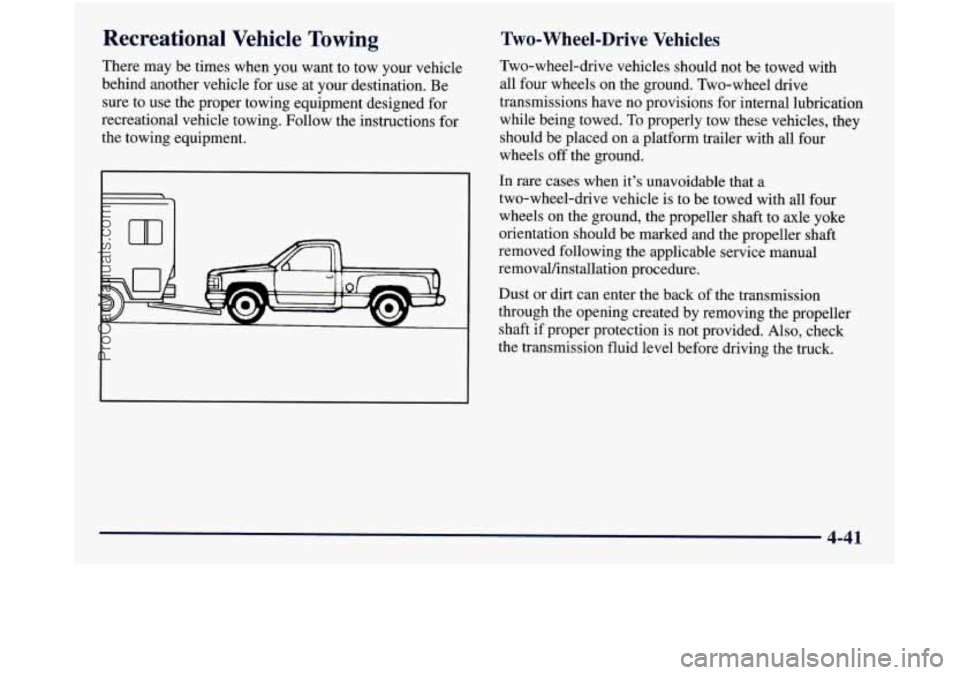
Recreational Vehicle Towing
There may be times when you want to tow your vehicle
behind another vehicle for use at your destination. Be
sure to use the proper towing equipment designed for
recreational vehicle towing. Follow the instructions for
the towing equipment.
I
I1
c
Two-Wheel-Drive Vehicles
Two-wheel-drive vehicles should not be towed with
all four wheels on the ground. Two-wheel drive
transmissions have no provisions for internal lubrication
while being towed. To properly tow these vehicles, they
should be placed on a platform trailer with all four
wheels off the ground.
In
rare cases when it's unavoidable that a
two-wheel-drive vehicle is to be towed with all 'four
wheels on the ground, the propeller shaft to axle yoke
orientation should be marked and the propeller shaft
removed following the applicable service manual
removal/installation procedure.
Dust or dirt can enter the back of the transmission
through the opening created by removing the propeller
shaft if proper protection is not provided. Also, check
the transmission fluid level before driving the truck.
4-41
ProCarManuals.com
Page 230 of 452
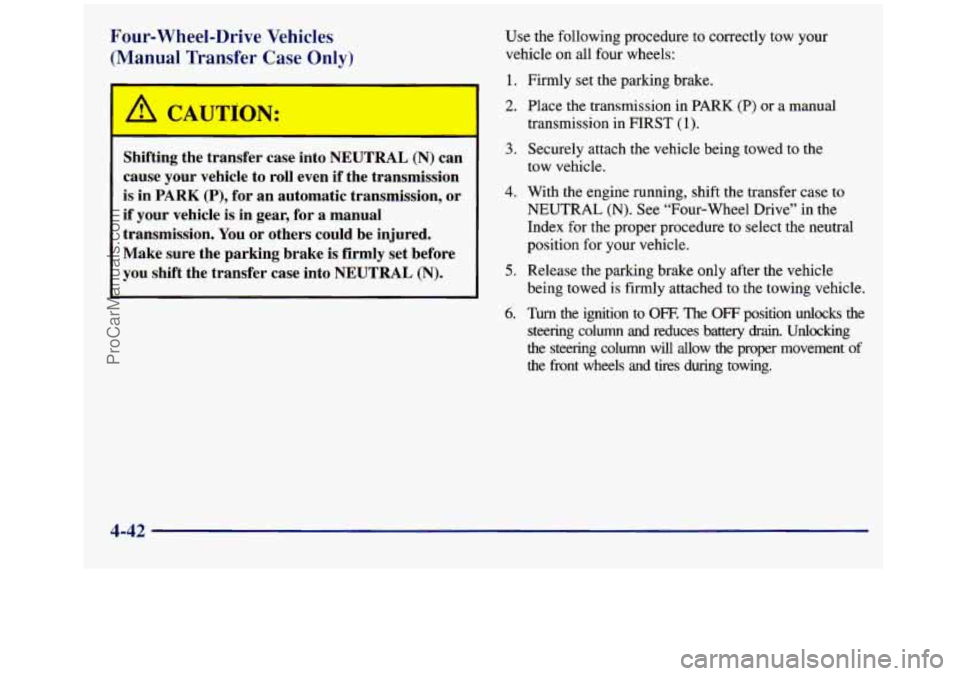
Four-Wheel-Drive Vehicles
(Manual Transfer Case Only)
‘A
-
Shifting the transfer case into NEUTRAL (N) can
cause your vehicle to roll even if the transmission
is in
PARK (P), for an automatic transmission, or
if your vehicle is in gear, for
a manual
transmission.
You or others could be injured.
Make sure the parking brake is firmly set before
you shift the transfer case into NEUTRAL (N).
Use the following procedure to correctly tow your
vehicle on all four wheels:
1.
2.
3.
4.
5.
6.
Firmly set the parking brake.
Place the transmission in
PARK (P) or a manual
transmission in FIRST
(1).
Securely attach the vehicle being towed to the
tow vehicle.
With the engine running, shift the transfer case to
NEUTRAL
(N). See “Four-wheel Drive” in the
Index for the proper procedure to select the neutral
position for your vehicle.
Release the parking brake only after the vehicle
being towed is firmly attached to the towing vehicle.
Turn the ignition to
OFF, The OFF position unlocks the
steering column and reduces battery
drain. Unlocking
the steering column will allow the proper movement
of
the front wheels and tires during towing.
4-42
ProCarManuals.com
Page 235 of 452
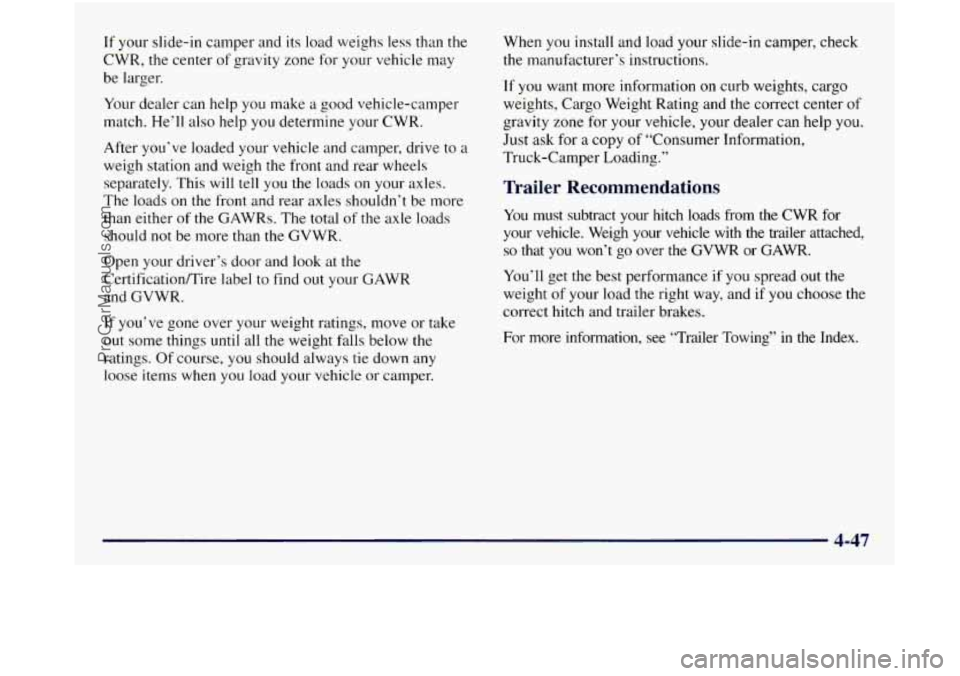
If your slide-in camper and its load weighs less than the
CWR, the center
of gravity zone for your vehicle may
be larger.
Your dealer can help you make a good vehicle-camper
match. He’ll also help
you determine your CWR.
After you’ve loaded your vehicle and camper, drive to a
weigh station and weigh the front and rear wheels
separately. This will tell you
the loads on your axles.
The loads on the front and rear axles shouldn’t be more
than either of
the GAWRs. The total of the axle loads
should
not be more than the GVWR.
Open your driver’s door and look at the
CertificatiodTire label to find
out your GAWR
and GVWR.
If you’ve gone over your weight ratings, move or take
out some things until all the weight falls below the
ratings.
Of course, you should always tie down any
loose items when you load your vehicle or camper. When you
install and load your slide-in camper, check
the manufacturer’s instructions.
If you want more information
on curb weights, cargo
weights, Cargo Weight Rating and the correct center of
gravity zone for your vehicle, your dealer can help
you.
Just ask for a copy of “Consumer Information,
Truck-Camper Loading.”
Trailer Recommendations
You must subtract your hitch loads from the CWR for
your vehicle. Weigh your vehicle with the trailer attached,
so that you won’t go over the GVWR or GAWR.
You’ll get the best performance if you spread out the
weight
of your load the right way, and if you choose the
correct hitch and trailer brakes.
For more information, see “Trailer Towing”
in the Index.
4-47
ProCarManuals.com
Page 237 of 452
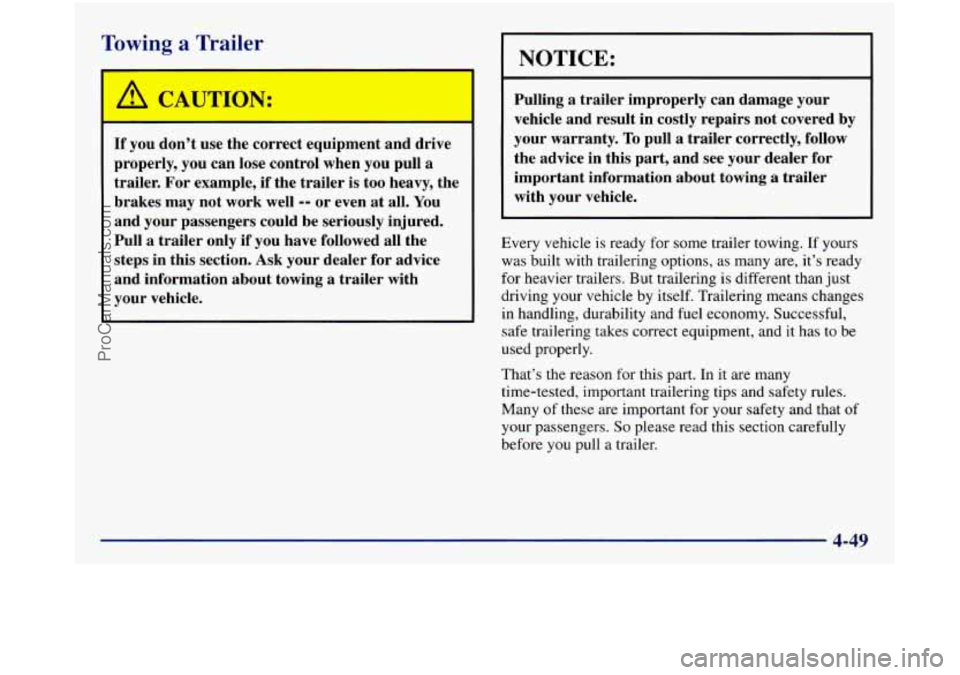
Towing a Trailer
If you don’t use the correct equipment and drive
properly, you can lose control when you pull
a
trailer. For example, if the trailer is too heavy, the
brakes may not work well
-- or even at all. You
and your passengers could be seriously injured.
Pull
a trailer only if you have followed all the
steps in this section. Ask your dealer for advice
and information about towing a trailer with
your vehicle.
NOTICE:
Pulling a trailer improperly can damage your
vehicle and result in costly repairs not covered by
your warranty.
To pull a trailer correctly, follow
the advice in this part, and see your dealer for
important information about towing a trailer
with your vehicle.
Every vehicle is ready for some trailer towing. If yours
was built with trailering options, as many are, it’s ready
for heavier trailers. But trailering is different than just
driving your vehicle by itself. Trailering means changes
in handling, durability and fuel economy. Successful,
safe trailering takes correct equipment, and it has to be
used properly.
That’s the reason for this part. In it
are many
time-tested, important trailering tips and safety rules.
Many of these are important for your safety and that of
your passengers.
So please read this section carefully
before
you pull a trailer.
4-49
ProCarManuals.com
Page 238 of 452

If You Do Decide To Pull A Trailer
If you do, here are some important points:
0
0
0
0
There are many different laws, including speed limit
restrictions, having to
do with trailering. Make sure
your rig will be legal, not only where you live but
also where you’ll be driving.
A good source for this
information
can be state or provincial police.
Consider using
a sway control if your trailer will
weigh less than
the capacity stamped on your step
bumper. You should always use a sway control
if
your trailer will weigh more than the capacity
stamped
on your step bumper. You can ask a hitch
dealer about sway controls.
Don’t tow a trailer at all during the first
500 miles
(800 km) your new vehicle is driven. Your engine,
axle or other parts could be damaged.
Then, during the first
500 miles (800 km) that you
tow
a trailer, don’t drive over 50 mph (80 kdh) and
don’t make starts at
full throttle. This helps your
engine and other parts
of your vehicle wear in at the
heavier loads.
0 If you have an automatic transmission, you can tow
in OVERDRIVE
(a). You may want to shift the
transmission to
THIRD (3) or, if necessary, a lower
gear selection if the transmission shifts too often
(e.g., under heavy loads and/or
hilly conditions). If
you have
a manual transmission and you are towing
a trailer, it’s better not to use
FIFTH (5) gear. Just
drive
in FOURTH (4) gear (or, as you need to, a
lower gear).
Three important considerations have
to do with weight:
0 the weight of the trailer,
0 the weight of the trailer tongue
0 and the weight on your vehicle’s tires.
Weigl- - 3e Trailer
How heavy can a trailer safely be?
It depends
on how you plan to use your rig. For
example, speed, altitude, road grades, outside
temperature and how much your vehicle is used to
pull a
trailer are all important. And,
it can also depend on any
special equipment that you have
on your vehicle.
4-50
ProCarManuals.com
Page 239 of 452
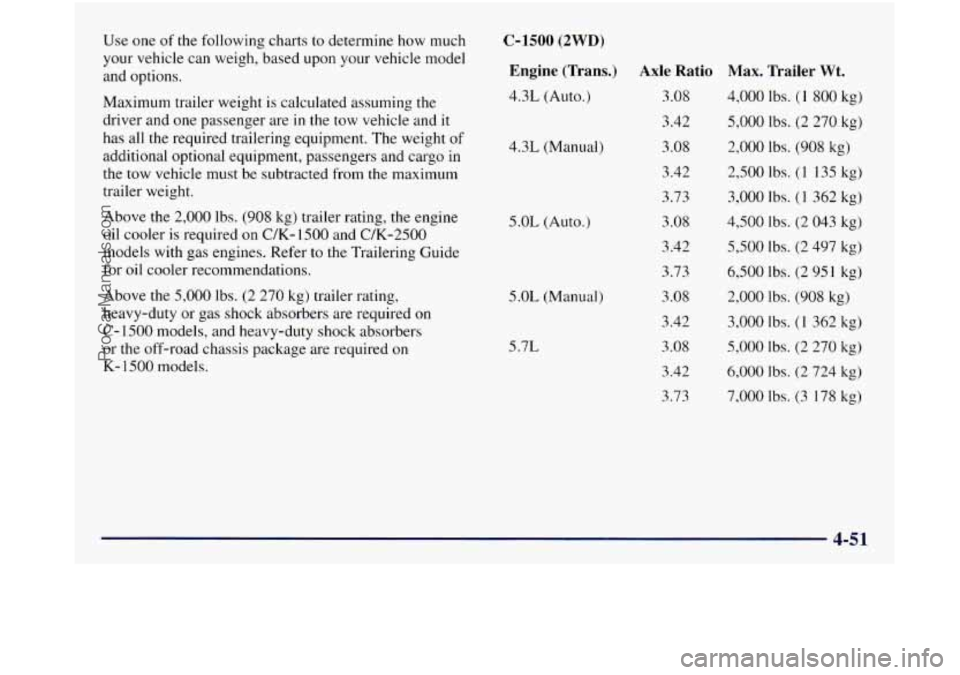
Use one of the following charts to determine how much
your vehicle can weigh, based upon your vehicle model
and options.
Maximum trailer weight is calculated assuming the
driver and one passenger are in the tow vehicle and
it
has all the required trailering equipment. The weight of
additional optional equipment, passengers and cargo in
the tow vehicle must be subtracted from the maximum
trailer weight.
Above the
2,000 lbs. (908 kg) trailer rating, the engine
oil cooler
is required on C/K- 1500 and C/K-2500
models with gas engines. Refer
to the Trailering Guide
for oil cooler recommendations.
Above the
5,000 lbs. (2 270 kg) trailer rating,
heavy-duty or gas shock absorbers are required
on
C- 1500 models, and heavy-duty shock absorbers
or the off-road chassis package are required on
K- 1500 models.
C-1500 (2WD)
Engine (Trans.)
4.3L (Auto.)
4.3L (Manual)
5.0L (Auto.)
5.0L (Manual)
5.x
Axle Ratio 3.08
3.42
3.08
3.42
3.73
3.08
3.42
3.73
3.08
3.42
3.08
3.42
3.73
Max. Trailer Wt.
4,000 lbs. (1 800 kg)
5,000 lbs. (2 270 kg)
2,000 lbs.
(908 kg)
2,500 lbs.
(1 135 kg)
3,000 lbs.
(1 362 kg)
4,500 lbs.
(2 043 kg)
5,500 Ibs. (2 497 kg)
6,500 Ibs. (2 951 kg)
2,000 lbs.
(908 kg)
3,000 Ibs. (1 362 kg)
5,000 lbs. (2 270 kg)
6,000 lbs. (2 724 kg)
7,000 lbs. (3 178 kg)
4-51
ProCarManuals.com